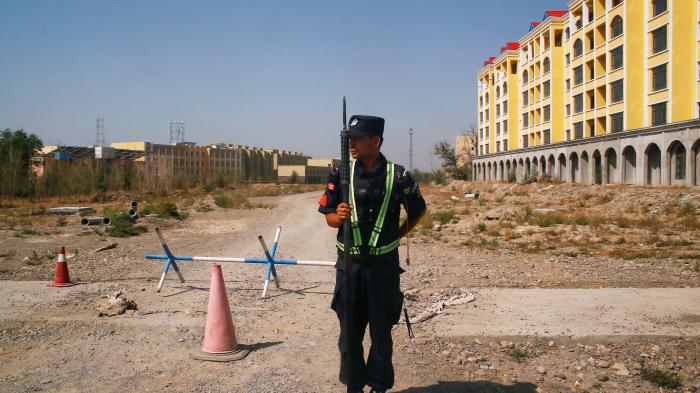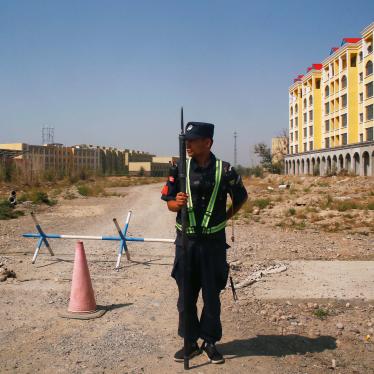摘要
“断代、断根、断联、断源一个不漏,彻底把‘两面人’的根子铲干净、挖干净,誓与‘两面人’斗争到底。”
——买苏木江・买木尔(Maisumujiang Maimuer),宗教事务官员,2017年8月10日,新华社微博
2014年5月,中国政府在新疆维吾尔自治区针对突厥裔穆斯林发动“严厉打击暴力恐怖活动专项行动”。1] 史丹福大学法律学院人权与冲突解决诊所和人权观察的研究,以及各人权组织、媒体、维权团体等各方面的报导,显示中国政府对当地突厥裔穆斯林人口已经实施——且仍在持续实施——危害人类罪行。[2]
本报告为前述结论提出事实基础,并基于国际法框架对中国政府在新疆作为的可得资讯进行评估。
根据《国际刑事法院罗马规约》,危害人类罪是指在明知对任何平民人口进行广泛或有系统攻击下,作为攻击的一部分而实施的重大特定罪行。“普遍”意指行为的规模或受害者的人数。“有系统”攻击是指形成模式或按部就班的计划。危害人类罪可以在和平时期或者武装冲突期间实施,只要它是针对平民人口。
危害人类罪被视为国际法上最严重的人权侵犯之一。本报告纪录的具体危害人类罪行包括:违反国际法的监禁或以其他形式剥夺自由;迫害一个可识别的族群或宗教群体;强迫失踪;酷刑;谋杀;以及疑似故意造成极大痛苦或对身心健康造成严重伤害的不人道行为,特别是强迫劳动和性暴力。
新疆维吾尔自治区位于中国西北部,是中国唯一以穆斯林人口占多数的地区。该地区包括维吾尔族、哈萨克族、柯尔克孜族及其他多个民族均属突厥裔族群。和中国多数民族即主要说中文的汉族不同,突厥裔人口多为穆斯林并有自己的母语。根据2010年人口普查,维吾尔族约占新疆人口的百分之46,哈萨克族约占百分之7。
中国政府对突厥裔穆斯林的镇压并不是新的现象,但在最近几年达到前所未见的程度。高达一百万人被任意拘禁在300到400间设施,[3] 包括“政治教育”营、看守所和监狱。[4] 法院未经正当程序即判下重刑,突厥裔穆斯林仅因向家属寄送伊斯兰宗教影音或下载维吾尔文电子书就被判处数年监禁。在押人员和囚犯受到酷刑和其他虐待、文化和政治思想灌输以及强迫劳动。这些镇压直到离开拘禁设施仍在持续:中国当局对突厥裔穆斯林施加广泛的大规模监控系统、限制迁徙、任意逮捕和强迫失踪、抹杀其文化与宗教、以及拆散家庭。
美国国务院和比利时、加拿大及荷兰国会皆已认定中国的行为亦构成国际法上的种族灭绝。人权观察目前尚未纪录到种族灭绝蓄意要件的存在。不过,本报告内容并不排除这种结论,而且,若有相关证据出现,目前针对新疆突厥裔穆斯林——作为受到1948年种族灭绝罪公约保护的一个群体——所实施的各种行为也可能支持种族灭绝的结论。
2017年,根据官方统计,新疆逮捕人数几乎占到全中国逮捕人数近百分之21,尽管新疆居民仅占全国人口的百分之1.5。从2017年起,中国当局利用各种不同理由损坏或摧毁了新疆三分之二的清真寺;其中近半遭彻底推平。全区主要的伊斯兰教圣地都被铲除。[5] 自治区当局以“结亲”名义实施侵入性的监控、发展与思想灌输计划,派遣官员干部到突厥裔穆斯林的家中留宿,美其名为“促进民族团结”。另一种骇人措施是,有些突厥裔穆斯林儿童因父母遭任意拘禁而被安置到孤儿院或寄宿学校、寄宿幼儿园等官方设施。[6]
这种种侵犯人权的举措已日益招致全球质疑。有些政府,如加拿大、欧盟、英国和美国,已经对中国政府官员与涉及侵犯人权的企业实施针对性或其他类型的制裁。越来越多国家加入在联合国人权理事会和联合国大会第三委员会(负责人权事务)发表的声明,谴责中国政府相关政策。然而,仍有许多国家对中国政府的新疆政策表示赞扬,包括伊斯兰合作组织的部分成员。
2019年7月,24个国家联名致函人权理事会主席,要求让联合国人权事务高级专员对新疆人权进行“有效视察”,监测并报告当地疑似侵犯穆斯林人口的行为。[7] 中国政府的反应是组织其他50个国家(不包括中国本身)发表联名信,签署者包括伊朗、北韩、沙特阿拉伯、委内瑞拉等人权纪录恶劣的国家。[8] 2019年11月,同一群国家又向联大第三委员会递交一份谴责声明。中国政府再次以54国联名信回应。[9]
2020全年,有关新疆人权侵犯的报导持续增加,使各国政府更难否认或忽视。 2020年6月,50个联合国特别程序——包括特别报告员、工作组和其他人权专家——对中国人权纪录发出强烈指控,包括中国政府对新疆、西藏的宗教和少数民族进行“集体镇压” 。专家们呼吁人权理事会就中国问题召开特别会议,成立专责监测中国的联合国机制,并要求联合国机构与各国政府施压中国履行人权义务。[10] 2020年10月,跨区域集团的39个国家发表公开声明,尖锐抨击中国政府在新疆、香港和西藏的普遍人权侵害。该声明大体上支持前述联合国50个特别程序的呼吁。[11]中国政府没有对相关指控进行调查,仅以两份声明回应,其中一份关于新疆的声明由古巴宣读,并有45国联署。[12]
调查中国危害人类罪
在发生严重人权侵害区域享有管辖权的国家,有义务确保相关罪行受到司法追究。该等国家有义务确保国内刑事司法机制就疑似人权侵害实施公正调查,并依据国际公正审判标准查明并起诉责任人。中国政府一再否认有官员在新疆涉及侵犯人权,既不愿自行调查也不允许独立的国际监察员实地调查。
历史上,未对严重人权侵犯进行调查的政府往往援引国家主权,拒绝其他有关当局如联合国机构或区域性国际组织前往调查。根据2002年生效的《国际刑事法院罗马规约》,若享有主要管辖权的国家缺乏意愿或能力,该法院即有权对疑涉危害人类罪及其他重大国际罪行的主要责任人进行调查和起诉。若涉嫌加害人是国际刑事法院缔约国的公民,若相关罪行发生在国际刑事法院成员国的领土,或若有非成员国请求国际刑事法院审查在其领土内发生的罪行,国际刑事法院便可实施调查与起诉。中国并非国际刑事法院成员国。虽然国际刑事法院可以在联合国安全理事会将新疆情势移交该法院时取得管辖权,但中国作为安理会常任理事国可以动用否决权阻止移交。
鉴于突厥裔穆斯林所受的迫害如此严重,有关各国迫切需要采取强硬、一致的问责行动。办法之一是由联合国成立调查委员会,对新疆人权侵犯的指控进行调查。调查委员会职权应包括认定事实、查明加害人和提出问责建议。委员会应由知名人士组成,包括国际人权法、危害人类罪、少数族群与宗敎权利以及性别议题等专家。委员会可以通过联合国人权理事会的决议成立,但联合国大会、联合国安理会和联合国秘书长也都有权采取相关行动。
本报告也对各有关国家提出其他建议,以便加强施压中国政府,改变其侵犯人权的新疆政策,包括追究相关罪行的个人刑责与国家责任、针对性制裁、以及根据其他联合国机制如《消除一切形式种族歧视国际公约》采取行动。
个别国家应当考虑刑事追诉——根据“普遍管辖权”(universal jurisdiction)概念,各国可以利用国内司法系统调查和起诉诸如酷刑等特定重大犯罪,即使犯罪地点不属该国领土。许多国家都已立法允许对被害人为本国国民的这类罪行加以起诉。各种人权条约,例如《反酷刑公约》和《反强迫失踪国际公约》,都要求缔约国引渡或起诉在其境内的嫌疑犯。根据国际习惯法,各国基本上可以对危害人类罪的嫌犯进行起诉。
建议
对中国政府
立即采取措施,终止对新疆和其他地区突厥裔穆斯林的人权侵害,特别是:任意拘押和监禁,包括所谓的“再教育”营;酷刑和其他虐待;限制宗教自由、隐私与迁徙;性暴力和强迫绝育;以及强迫劳动。
立即采取措施,终止对突厥裔穆斯林的疑涉危害人类罪行。
调查并适当起诉涉嫌严重侵犯人权和危害人类罪的政府官员。
对联合国
联合国人权理事会应通过决议成立调查委员会,并授予下列权限:
调查以新疆突厥裔穆斯林为目标的疑涉危害人类罪和其他人权侵害行为,包括:非法监禁或其他形式严重剥夺人身自由;基于政治、种族、民族、族群、文化或宗教理由迫害某个可识别团体;强迫失踪;酷刑;谋杀;其他不人道行为,包括强迫劳动;限制宗教自由;性暴力;以及侵犯生育权利;
作出终止相关侵犯行为的建议;
指出负责官员并提出将其绳之以法的具体途径;
呼吁给予受害者和幸存者适当赔偿;以及
定期向理事会和联合国其他相关机构提交报告。
联合国人权事务高级专员应履行其独立监察和报告的职权,收集相关资讯,就其结论发表公开抗议,为新疆人权情势撰写报告,并定期向人权理事会提供更新资讯。
联合国各种特别程序应就其职权对中国当局在新疆侵犯人权进行持续纪录和公开报导,据以支持设立调查委员会或类似的调查机制。
联合国秘书长应公开支持对新疆人权侵犯成立调查委员会,并在公开和私下敦促中国当局终止对新疆突厥裔穆斯林的迫害。秘书长应公开支持对发生在新疆的危害人类罪行追究责任。
联合国大会应要求负责调查新疆人权侵犯的委员会也向大会提交报告,并将相关报告转交给所有联合国成员国和联合国有关机构。
大会应通过决议,公开支持具体问责措施,包括对危害人类罪的责任人实施针对性制裁。
联合国安全理事会成员国应在中国作为常任理事国的条件下采取最大可能的行动,包括通过阿里亚办法(Arria Formula)会议或其他途径,对于成立委员会调查新疆人权侵害表达支持。
对有关各国政府
协调一致的双边或多边行动
依据美国《全球马格尼茨基法》和类似的政府间或国内法律工具,实施签证禁令、旅游禁令和针对性个别制裁;这种制裁若以集体方式实施将更有成效。
在所有谴责新疆人权侵犯的个别或联合声明中,指出中国当局应为犯罪行为负责,这些行为是针对新疆突厥裔穆斯林的普遍且有系统攻击的一部分,构成危害人类罪。
基于普遍管辖权的法律基础,协助起诉涉及危害人类罪的中国官员。
鼓励本国检察官发动框架性调查,即类似国际刑事法院的初步审查,由检察机关针对疑涉严重违法行为收集并分析有关资讯,为将来起诉奠定基础。
对既经证实协助中国在新疆执行大规模监控的科技业者实施更强硬行动,包括引用《全球马格尼茨基法》和类似的制裁措施。
- 《消除一切形式种族歧视国际公约》缔约各国应就中国对突厥裔穆斯林的违反公约行为提出个别或联合控诉。
关于贸易、投资和商业活动
有关政府机构应审查所有对新疆的投资,并在必要时针对据可靠指控涉及严重侵害(例如强迫劳动)的产业部门实施贸易制裁,包括撤资。
向企业发出类似加拿大于2021年1月针对下列议题所做的公开建议:
新疆人权侵害的严重性,包括强迫劳动;
企业依据国际法和国内法应负的法律责任;
因直接商业活动和供应链成为人权侵害共犯的风险;以及
对于在中国一切商业交易应进行透明及彻底人权尽职调查的责任。
在有关强迫劳动的举报得到独立且公正的国际专家调查、侵害得到解决、加害者受到追究且受害者得到赔偿之前,欧盟不应将《欧中投资协定》送交欧洲议会通过。
呼吁工商业者公开发布在新疆开展业务对象的名称、地址、所有权及其他相关详情。
立法规定在新疆运营企业必须执行人权尽职调查。
检讨国际金融机构的投资组合,确保其不致参与该地区的迫害行为。
对境内有突厥裔流亡社群的各国
确保突厥裔穆斯林申请庇护能够得到公正制度的裁决。
允许突厥裔穆斯林的家属入境团聚,以协助家庭团聚。
终止一切遣返措施及其他形式直接或间接强迫突厥裔穆斯林返回中国。
建立机制以追踪发生在其他国家的骚扰突厥裔穆斯林案件,并采取包括刑事司法在内的措施以追究加害者责任。
确保突厥裔穆斯林能够获得为酷刑、强暴和其他犯罪被害人提供的法律、医疗和心理援助,以及文化与宗教保存方案。
对企业和投资者
认识到目前在新疆因为政府干预已不可能履行联合国《工商企业与人权指导原则》要求承担的人权尽职调查责任。
加入为终止涉及突厥裔穆斯林强迫劳动做法的“行动呼吁”,或采取类似措施。

